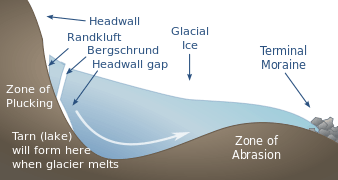Randkluft
A randkluft (from the German for marginal cleft/crevasse) or rimaye (from the same French IPA: [ʁimaj]) is the headwall gap between a glacier or snowfield and the adjacent rock face at the back of the cirque[1] or, more loosely, between the rock face and the side of the glacier.

In French, the word rimaye covers both notions of randkluft and bergschrund.
Formation
It is formed by the melting of ice against warmer rock and may be very deep. During summer therefore, a randkluft will become wider and thus more difficult for climbers to negotiate. Randklufts are often found in relatively low-lying glaciers such as the Blaueis in the Berchtesgaden Alps or the Höllentalferner in the Wetterstein.
A randkluft is similar to, but not identical with, a bergschrund, which is the place on a high-altitude glacier where the moving ice stream breaks away from the static ice frozen to the rock creating a large crevasse. Unlike a randkluft, a bergschrund has two ice walls.
Gallery
 Wide randkluft on the east face of the Watzmann
Wide randkluft on the east face of the Watzmann Alpinists over the randkluft of the Höllentalferner glacier
Alpinists over the randkluft of the Höllentalferner glacier
See also
References
- Whittow, John (1984). Dictionary of Physical Geography. London: Penguin, 1984, p. 438. ISBN 0-14-051094-X.
External links
- Cryosphere Glossary, National Snow and Ice Data Center
- Photo of the randkluft on the Höllentalferner